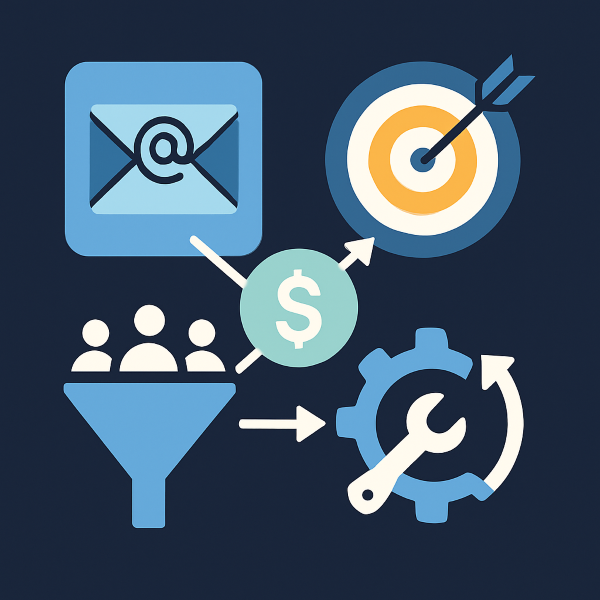
Email marketing remains one of the most potent channels for affiliates: you own the list, you control the message, and you can drive consistent affiliate revenue if done right. But not all email platforms are created equal — some restrict affiliate link usage, some lack automation or funnel features, some struggle with deliverability.
In this guide you’ll discover:
-
What “affiliate‑friendly” really means for an email tool
-
A side‑by‑side comparison of four leading platforms you’re considering: GetResponse, Systeme.io, AWeber, ConvertKit
-
Clear advice on how to choose the right tool for your affiliate business
-
Best‑practice tactics to run affiliate email campaigns that deliver
Let’s dive in.
What “Affiliate‑Friendly” Means for an Email Marketing Tool
Before you pick a tool, check for the following to ensure smooth affiliate marketing:
1. Acceptable Use Policy (AUP) for affiliate links
Some email service providers explicitly forbid or heavily restrict affiliate links in emails. You want a tool whose policy allows affiliate link usage (or at least does not prohibit it) so you don’t risk your list being flagged or your account suspended. For example, sources note that GetResponse “is one of the most pro‑affiliate email marketing platforms out there.” EmailTooltester.com+2Email vendor selection+2
2. Deliverability & reputation
Even if a tool allows affiliate links, your success will depend on how often your emails land in inboxes (not spam). Look for platforms with good deliverability history, segmentation features, list validation, dedicated IPs (if needed) and good infrastructure. xperiencify.com+1
3. Automation & funnel capabilities
Affiliate marketing often benefits from sequences: welcome, nurture, affiliate offer, follow‑up, upsell, etc. So you’ll want automation workflows, segmentation by behavior (e.g., clicked link, did not open), tagging, triggers. The more advanced the automation, the better your ability to scale. Email vendor selection+1
4. Tracking, analytics & integration
You need visibility: open rates, click‑through rates, conversion tracking (or at least integration with your affiliate tracking). Also, integration with landing page builders, forms, and funnels helps you build full affiliate flows. Omnisend+1
5. Cost & scalability for affiliates
Affiliate marketers require that the tool not get prohibitively expensive as their list grows. Some tools charge based on number of contacts, others on number of emails sent. Evaluate plan structure and growth‑cost. Email vendor selection+1
Side‑by‑Side Comparison Table
Here’s a quick comparison of the four tools you mentioned, focused on affiliate‑marketing suitability:
| Tool | Affiliate Link Policy | Key Strengths for Affiliates | Potential Weaknesses |
|---|---|---|---|
| GetResponse | Explicitly supports affiliate marketing. | Very strong automation/funnel features; supports building landing pages; good affiliate‑friendly reputation. | Pricing may escalate with larger lists; complexity might be higher for beginners. |
| Systeme.io | Positioned as all‑in‑one (funnels + email) and friendly to affiliate workflows. | Good for affiliates who also build funnels/membership sites; cost‑effective especially for beginners. | Maybe less specialised purely for email (versus full funnel stack); forensic deliverability track record may be less established. |
| AWeber | Known affiliate‑friendly; integrates with affiliate networks. | Proven brand, strong deliverability, relatively simple to use. | Might lack some of the advanced funnel/automation depth compared with top tools; cost may climb with list size. |
| ConvertKit (Kit) | Good for creators/bloggers; supports affiliate campaigns to some extent. | Great tagging/segmentation, friendly interface; good if you’re content‑creator type. | May not be as funnel‑heavy or affiliate‑link‑centric as some alternatives; pricing may jump for large contact counts. |
How to Pick the Right Tool for Your Affiliate Business
Here are scenarios + recommended options:
-
You’re just starting out, small list, budget‑sensitive → Choose a tool with a good free or cheap starter plan + affiliate‑friendly policy (Systeme.io or AWeber can fit).
-
You’re promoting many affiliate offers, need funnel + membership site + automation → Go for GetResponse or Systeme.io which combine funnel/email/landing page capabilities.
-
You’re a creator/blogger with digital products + affiliate offers, list growth oriented → ConvertKit might be a fit thanks to its creator‑marketing focus and ease of use.
-
Deliverability is your top concern (due to large list/active affiliate campaigns) → Prioritise a platform with proven deliverability and strong email infrastructure (GetResponse or AWeber).
-
You want the simplest possible setup, minimal tech → AWeber or ConvertKit provide simpler interfaces; the trade‑off may be lesser funnel depth.
Checklist before you commit:
-
Check their AUP: affiliate links allowed? any restrictions?
-
What’s the pricing as your list grows to e.g., 10k, 50k contacts?
-
How good is the automation: can you trigger on click, tag subscribers, build multi‑step flows?
-
Does it integrate with your landing pages/funnel builder or can you use the built‑in one?
-
What deliverability reputation does the tool have (look for reviews, case‑studies)?
-
Does the tool support exporting data or integrating with your affiliate tracking?
-
Does it allow you to test / A/B split subject lines, email content (important for optimisation)?
Best Practices for Running Affiliate Email Campaigns
To maximise success with email + affiliate links, follow these guidelines:
-
Build your list the right way
-
Use opt‑in forms, lead magnets that attract your target audience (not just “free” list)
-
Provide value first, build trust before sending affiliate offers.
-
-
Segment your subscribers
-
Tag based on behavior: e.g., clicked a link, visited a funnel page, downloaded a lead magnet.
-
Then send targeted affiliate offers that match their interest (vs blanket blasts).
-
-
Use sequences rather than one‑off blasts
-
A welcome series (educate about you, your niche)
-
Then gradually introduce an affiliate offer (don’t push too early)
-
Follow up to non‑clickers / non‑converters with nurture content or alternate offers.
-
-
Be transparent & compliant
-
Disclose affiliate links (FTC rules etc)
-
Avoid spammy subject lines or over‑promoting high‑risk affiliate offers.
-
Focus on value, not just the sale.
-
-
Monitor and optimise
-
Track open rates, click rates, conversion rates.
-
Use A/B testing for subject lines, email copy, CTA placement.
-
Clean your list (remove inactive subscribers) to keep deliverability healthy.
-
-
Choose the right offers and pacing
-
Promote affiliate offers that align with your audience’s needs/interests.
-
Use timing wisely: don’t bombard with offers; mix in value content.
-
Consider high‑commission + high‑conversion offers rather than chasing massive commissions with poor conversion.
-
-
Deliverability guardrails
-
Warm up new account/list (send to smaller segments first)
-
Use authenticated domain, proper sender reputation
-
Avoid misleading subject lines, heavy use of affiliate links in every email.
-
Monitor spam/feedback loops.
-
-
Use tools & automation to scale
-
Use your ESP’s tagging/triggering to automate when to send offers after certain actions.
-
Integrate with your landing/funnel builder to capture leads, then automate follow‑ups with affiliate offers.
-
Use link tracking so you know which subscribers clicked and convert, then send them further offers or upsells.
-
Frequently Asked Questions (FAQ)
Q: Can I send affiliate links in an email campaign?
A: Yes—provided your email service provider allows it and your affiliate offer is compliant. Always check the ESP’s acceptable use policy. For example, sources highlight some tools explicitly support affiliate email marketing. EmailTooltester.com+1
Q: Do I need a funnel/builder for affiliate email marketing?
A: It depends on your strategy. If you’re just sending emails with affiliate links you may not. But for higher scale or recurring income, building a funnel (opt‑in → nurture → offer → follow‑up) helps. The better email platforms integrate funnel or landing page features.
Q: At what list size should I upgrade my tool or plan?
A: When your email volume, segmentation needs, or automation workflows increase significantly—e.g., you’re sending weekly sequences, targeting many segments, or have strict deliverability concerns. Always check cost‑structure ahead of growth.
Q: What are good deliverability benchmarks for affiliate emails?
A: While it varies by niche, open rates of 20–30% (for affiliate‑niche) and click‑through rates of 2–5% are reasonable starting points. But your list quality (engagement, opt‑in origin) will heavily impact results.
Conclusion
Affiliate email marketing can be highly profitable when you choose the right email platform and apply the right tactics. Among the tools you’re considering:
-
GetResponse stands out for full features and affiliate‑friendliness.
-
Systeme.io is strong if you also build funnels and want cost‑efficient growth.
-
AWeber offers reliability and strong deliverability.
-
ConvertKit is great for creators/bloggers with simpler flows.
Your best move: pick the tool that fits your current scale, your affiliate offer style, and your budget for growth. Then implement the best practices above: build value, segment intelligently, automate smartly, and track everything.
